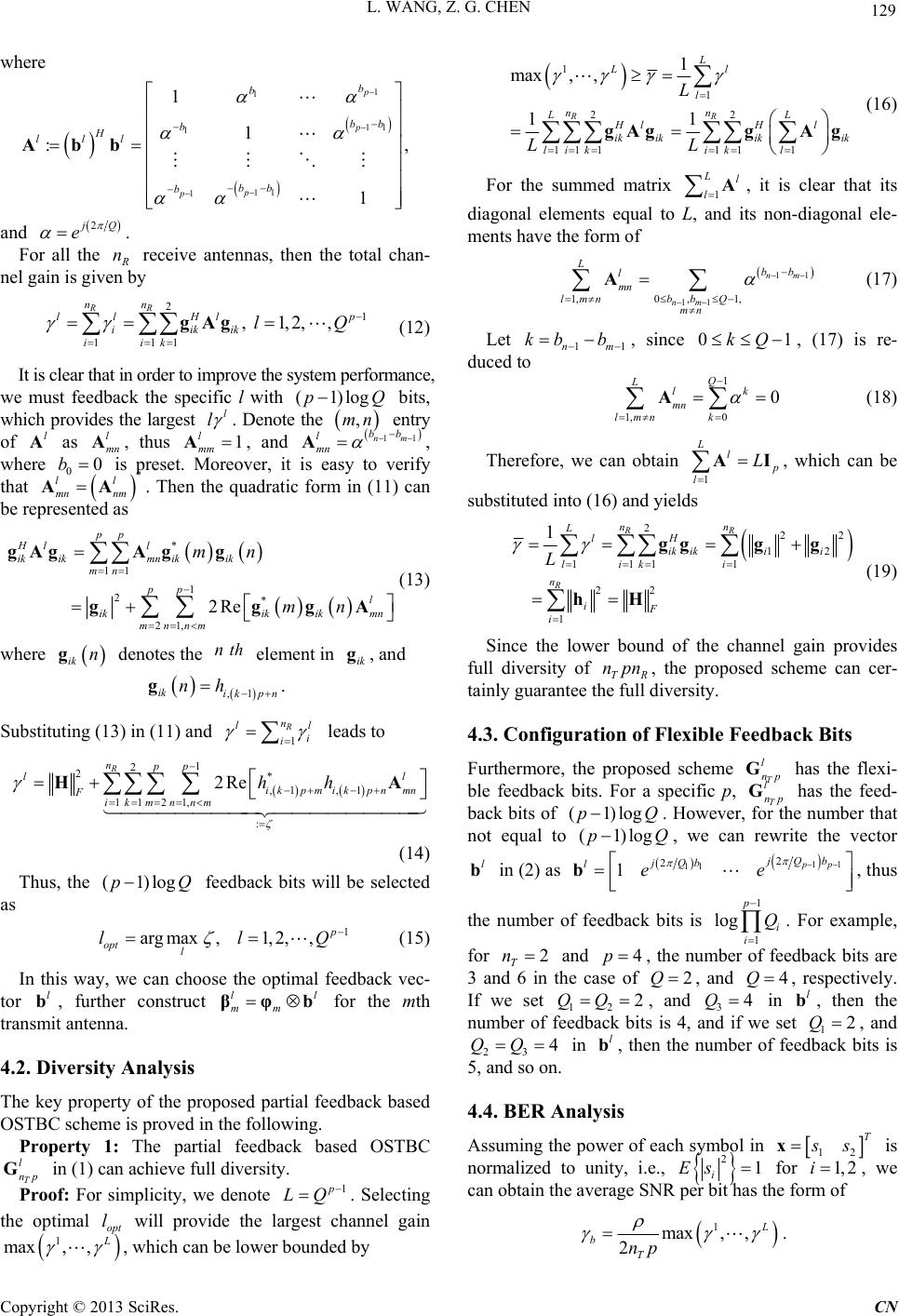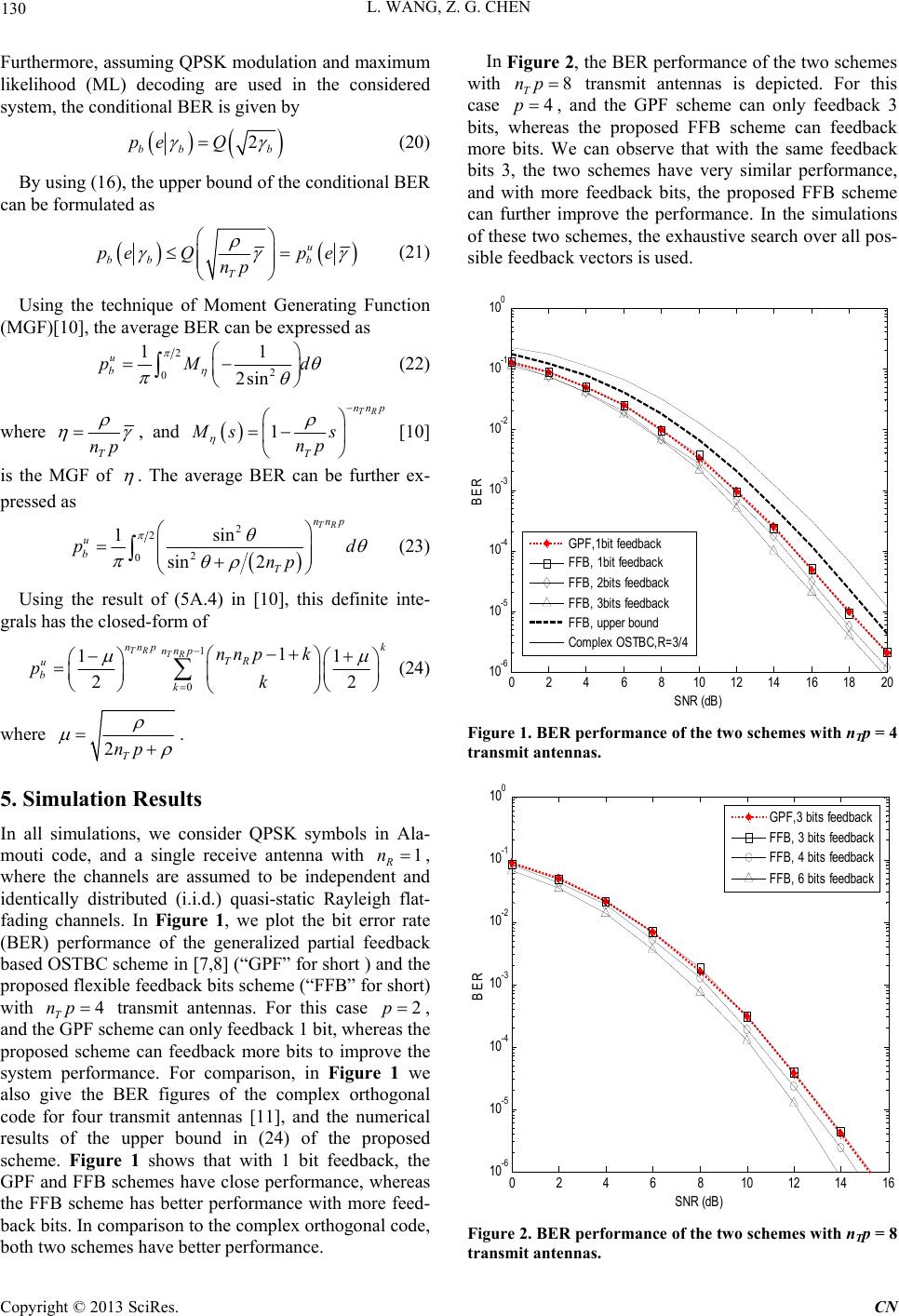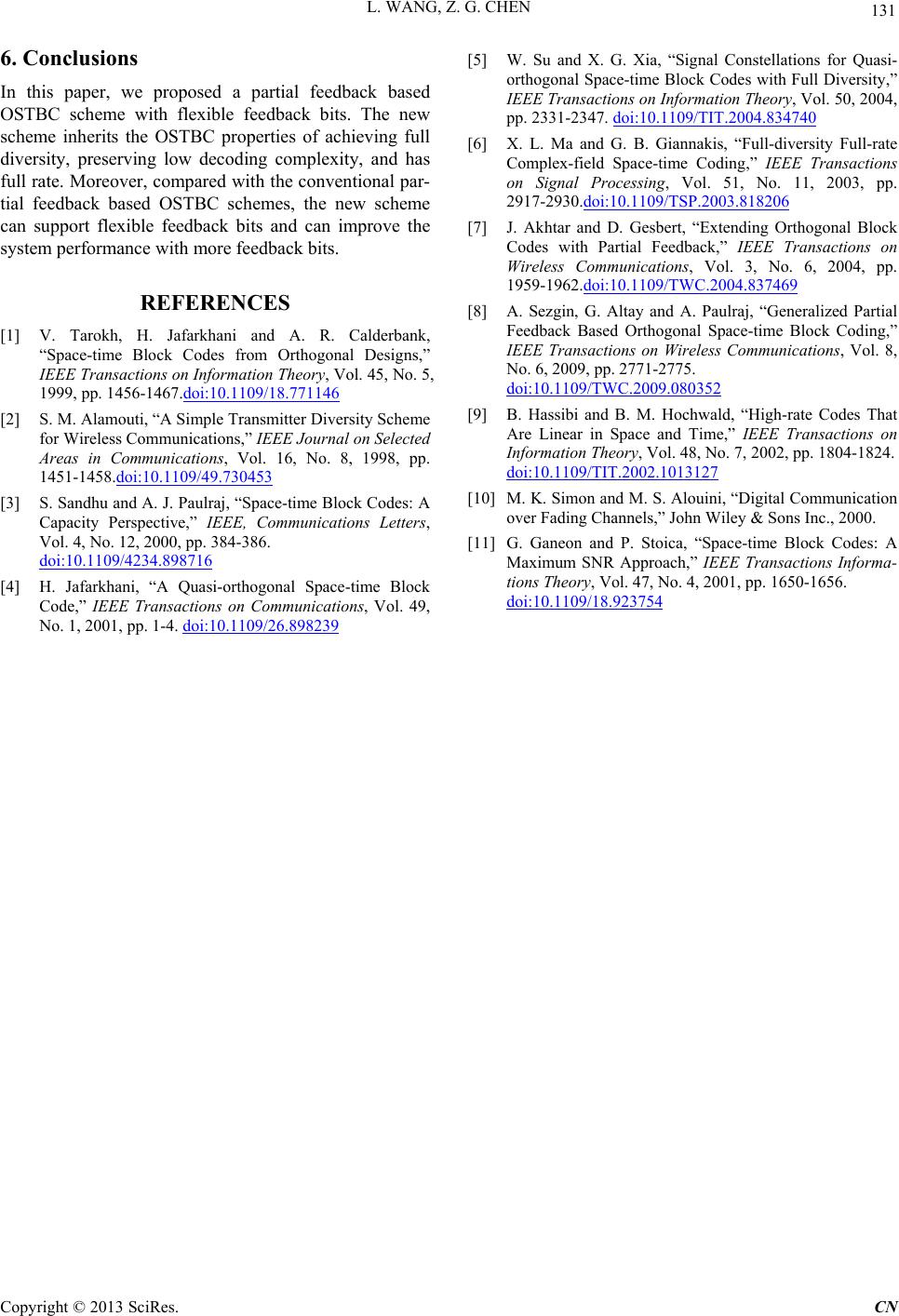 Communications and Network, 2013, 5, 127-131 http://dx.doi.org/10.4236/cn.2013.53B2024 Published Online September 2013 (http://www.scirp.org/journal/cn) Partial Feedback Based Orthogonal Space-Time Block Coding With Flexible Feedback Bits* Lei Wang, Zhigang Chen School of Electronics and Information Engineering, Xi’an Jiaotong University, Xi’an, China Email: lei.wang@mail.xjtu.edu.cn, zgchen@mail.xjtu.edu.cn Received June, 2013 ABSTRACT The conventional orthogonal space-time block code (OSTBC) with limited feedback has fixed feedback bits for the specific transmit antennas. A new partial feedback based OSTBC which provides flexible feedback bits is proposed in this paper. The proposed scheme inherits the properties of having a simple decoder and the full diversity of OSTBC, moreover, preserves full data rate. Simulation results show that for transmit antennas, the proposed scheme has the similar performance with the conventional one by using 1p T np T np 1p feedback bits, whereas has the better performance with more feedback bits. Keywords: MIMO; Transmit Diversity; Space-time Block Coding; Parti a l Feed b ack 1. Introduction Orthogonal space-time block coding (OSTBC) is a sim- ple and effective transmission paradigm for MIMO sys- tem, due to achieving full diversity with low complexity [1]. One of the most effective OSTBC schemes is the Alamouti code [2] for two transmit antennas, which has been adopted as the open-loop transmit diversity scheme by current 3GPP standards. However, the Alamouti code is the only rate-one OSTBC scheme [3]. With higher number of transmit antennas, the OSTBC for complex constellations will suffer the rate loss. Focusing on this drawback, the open-loop solutions have been presented, such as the quasi-OSTBC (QOS- TBC) [4] with rate one for four transmit antennas, and other STBC schemes [5,6] with full rate and full diver- sity. Alternatively, the close-loop solutions have also been designed to improve the performance of OSTBC by exploiting limited channel information feedback at the transmitter. In this paper, we focus on the close-loop scheme. Based the group-coherent code, the bits feed- back based OSTBC for T transmit antennas has been constructed in [7], and generalized to an arbitrary number of receive antennas in [8]. The partial feedback based schemes in [7,8] exhibit a higher diversity order while preserving low decoding complexity. However, these schemes for transmit antennas require a fixed number of 1p np T np 1p bits feedback. That is to say, for such scheme, improving the performance by increasing the feedback bits implies that the number of transmit anten- nas T must be increased at the same time. Therefore, the scheme is inflexible in compromising the perform- ance and the feedback overhead. np In this paper, by multiplying a well-designed feedb ack vector to each signal to be transmitted from each antenna, we propose a novel partial feedback based OSTBC scheme with flexible feedback bits. In this scheme, the OSTBC can be straightly extended to more than two an- tennas. Importantly, we can show that the proposed scheme preserves the simple decoding structure of OS- TBC, full diversity and full data rate. Notations: Throughout this paper, and T represent “transpose” and “Hermition”, respectively. aRe denotes the real part of a complex , and a 1j . 2. Proposed Code Construction and System Model Consider a MIMO system with transmit and T np n n G receive antennas. Assuming we have an OSTBC T for transmit antennas, and can be denoted as T nT n G 12 T nT n c cGc, where is the m c1T sig- *This work was supported by the National Natural Science Foundation of China under Grant 60902045, the International Cooperation Projects of China-Finland under Grant 2010DFB10570, and the National Sci- ence & Technology Major Projects of China under Grant 2010ZX- 03003-004. C opyright © 2013 SciRes. CN  L. WANG, Z. G. CHEN 128 nal to be transmitted from the mth antenna for . Then a code to be transmitted from T antennas, where is an integer, may be con- structed as 1,, T mn l m np 2p 1 T T n l npm m m Gcβ (1) where is the 1T feedback vector for the th antenna, which is defined as , where l m βnpll mm βφb denotes the Kronecker product, m is the th row of the identity matrix , and φm p T n I1 vector is given by l b 1 12 2 :1 p jQb jQb lee b (2) where . For the feedback vector at the mth antenna, it contains a subset of all pos- sible 11 ,,0,1,, 1 p bb AQ 1 Ql m β feedback vectors , i.e., 1 1, 2,, lQ . With the transmission of T Tnp code matrix T np G, the l Tn receive signal can be written as 1,,R n y Yy T l np YG HN (3) where is the channel ma- trix, and is the 1,,R n Hhh 1,,R n Nnn T np nR Tn H complex Gaus- sian noise matrix. The entries of and are inde- pendent samples of a zero-mean complex Gaussian ran- dom variable with variance 1 and N T np respectively, where is the average signal-to-noise ratio (SNR) at each receive antenna. 3. Linear Decoder at the Receiver The received signal at ith receive antenna can be re- written as TT T ll inpiini l ni i y Ghn GBhn Gh n i (4) where the TT matrix is composed of T feedback vectors, and can be expressed in a stacked form given by nnpl Bn 1T T T T ll l n Bββ . We divide channel vector into seg- ments in the following way 1 T npi hT n 1 ,1,,(1) 1, :: ,, ,,,, TT TT iinT T ii ipinpipn hh hh gg h (5) where each segment can be denoted as ( ik g1,, T kn ) with dimension . Then the equivalent channel vec- tor in (4) has the form of 1p ll i hBh i i 1 12 T T T ll l iin T ll l ii in φbh φbh bg bgbg h i y (6) For convenience, we will use th e Alamouti code as the basic OSTBC matrix T n in the rest of this paper, and the results can be straightly extended to other OSTBC. For the received signal in (4), After performing the con- jugate operation to the second entry of , the received signal can be equivalently expressed as G i y l ii i yRxn (7) where is the equivalent channel matrix correspond- ing to the entries of and their conjugates, and l i R 12 T l i h sx has a pair of symbols in the Alamouti code. Denote the kth entry of as , and ac- cording to the linearity of th e OSTBC [9], the equivalent channel matrix has the form of l i h l ik h l i R 2 * 1 ll l ikiki k kk RChDh (8) where the matrices k and k D specifying the Alamouti code are defined in [9]. Since matched filtering is the first step in the detection process, left-multiplying by C i y l i Rwill yield HH lll iiii i rR i MxRn (9) where . Due to the properties of and for the Alamouti code, we get H ll ii R l i MR k D k C 22 11 2 22 12 l i ll l ii i ll ii Mh h CD hI I (10) where denotes the equivalent channel gain for re- ceive antenna i. It is clear that is a diagonal matrix, therefore, the simple decoder of OSTBC can be straightly applied for (7), thus l i M 1 and 2 can be decoded inde- pendently. 4. Feedback Bits Selection and Properties In this section, we will discuss the feedback bits selection criterion and the key properties of the proposed scheme. 4.1. Feedback Bits Selection At the th receive antenna, il i can be expressed in the following quadratic form 2 222 12 1 ll llHl iiiiikik k hbgbg gAg (11) Copyright © 2013 SciRes. CN  L. WANG, Z. G. CHEN 129 where 1 1 11 1 11 1 1 1 :, 1 p p p p b b bb b H lll bb b Abb and 2 Q e . For all the n receive antennas, then the total chan- nel gain is given by 21 111 , 1,2,, RR nn ll Hl iikik iik l p Q gAg (12) It is clea r that in orde r to im prove t he sy stem perform anc e, we must feedback the specific l with bits, which provides the largest (1)logpQ l l . Denote the entry of as , thus ,mn l Al mn A1 l mm A, and 11m bb n l mn A, where preset. Moreover, it is easy to verify that nm . Then the quadratic form in (11) can be represented as 0 b mn A 0 is l A * l * 11 1 2* 21, 2Re pp Hl l ikikmn ikik mn pp l ikik ikmn mnnm mn mn gAgA gg gggA l (13) where denotes the n element in , and ik ngthik g ,1 ik ik pn nh g. Substituting (13) in (11) and 1 R n li i leads to 1 2 2* ,1 ,1 1121, : 2Re R npp l l mn ik pmik pn Fikmnnm hh H A Q (14) Thus, the feedback bits will be selected as (1)logp 1 argmax ,1,2,, opt l ll Q l (15) In this way, we can choose the optimal feedback vec- tor , further construct for the mth transmit antenna. l bl mm βφb 4.2. Diversity Analysis The key property of the proposed partial feedback based OSTBC scheme is proved in the following. Property 1: The partial feedback based OSTBC in (1) can achieve full diversity. T Proof: For simplicity, we denote l np G 1 LQ . Selecting the optimal will provide the largest channel gain opt l 1 max, , 1 1 22 11111 1 1 max, , 11 RR L Ll l nn LL HlHl ik ikikik likik l L LL gAggA g (16) For the summed matrix , it is clear that its 1 Ll l A diagonal elements equal to L, and its non-diagonal ele- ments have the form of 11 11 1,0 ,1, nm nm Lbb l mn lmnbb Q mn A 1 (17) Let 1nm kb b , since 0, (17) is re- duced to 1kQ 1 1,0 0 Q Llk mn lmn k A (18) Therefore, we can obtain 1 Ll l L AI , which can be substituted into (16) and yields 222 12 1111 22 1 1 RR R nn LlH ik ikii lik i n iF i L ggg g hH (19) Since the lower bound of the channel gain provides full diversity of TR , the proposed scheme can cer- tainly guarantee the full diversity. npn 4.3. Configuration of Flexible Feedback Bits Furthermore, the proposed scheme has the flexi- ble feedback bits. For a specific p, T has the feed- back bits of T l np Gl np G (1)logpQ . However, for the number that not equal to (1)logpQ , we can rewrite the vector l b in (2) as 11 11 2 2 1pp jQb jQb lee b, thus the number of feedback bits is . For example, 1 1 log p i i Q for 2 T n and 4p , the number of feedback bits are 3 and 6 in the case of 2Q , and , respectively. If we set 12 4Q 2QQ , and 3 Q in , then the number of feedback bits is 4, and if we set 1 4l bQ2 , and 23 4QQ in , then the number of feedback bits is 5, and so on. l b 4.4. BER Analysis Assuming the power of each smbol in y 12 T sx is normalized to unity, i.e., 21 i Es for 1,2i , we can obtain the average SNR per bit has the form of 1 max, , 2 bT np . , which can be lower bounded by Copyright © 2013 SciRes. CN  L. WANG, Z. G. CHEN 130 Furthermore, assuming QPSK modulation and maximum likelihood (ML) decoding are used in the considered system, the conditional BER is given by 2 bb b pe Q (20) By using (1 6), th e upp e r bound o f the cond itio n al BER can be formulated as u bb b T pe Qpe np (21) Using the technique of Moment Generating Function (MGF)[10], the average BER can be expressed as 2 2 0 11 2sin u b pM d (22) where T np , and 1 TR nnp T Ms s np [10] is the MGF of . The average BER can be further ex- pressed as 2 2 2 0 1sin sin 2 TR nnp u b T pd np (23) Using the result of (5A.4) in [10], this definite inte- grals has the closed-form of 1 0 1 11 22 TR TR nnp k nnp TR u bk nnp k pk (24) where 2T np . 5. Simulation Results In all simulations, we consider QPSK symbols in Ala- mouti code, and a single receive antenna with 1 R n , where the channels are assumed to be independent and identically distributed (i.i.d.) quasi-static Rayleigh flat- fading channels. In Figure 1, we plot the bit error rate (BER) performance of the generalized partial feedback based OSTBC scheme in [7,8] (“GPF” for short ) and the proposed flexible feedback bits scheme (“FFB” for short) with transmit antennas. For this case 4 T np2p , and the GPF scheme can only feedback 1 bit, whereas the proposed scheme can feedback more bits to improve the system performance. For comparison, in Figure 1 we also give the BER figures of the complex orthogonal code for four transmit antennas [11], and the numerical results of the upper bound in (24) of the proposed scheme. Figure 1 shows that with 1 bit feedback, the GPF and FFB schemes have close performance, whereas the FFB scheme has better performance with more feed- back bits. In comparison to the complex orthogonal code, both two schemes have better performance. In Figure 2, the BER performance of the two sch emes with 8 T np transmit antennas is depicted. For this case 4p , and the GPF scheme can only feedback 3 bits, whereas the proposed FFB scheme can feedback more bits. We can observe that with the same feedback bits 3, the two schemes have very similar performance, and with more feedback bits, the proposed FFB scheme can further improve the performance. In the simulations of these two schemes, the exhaustive search over all pos- sible feedback vectors is used. 0 2 46810 12 1416 18 20 10 -6 10 -5 10 -4 10 -3 10 -2 10 -1 10 0 S NR (dB) BER GP F ,1 bi t feedback FF B, 1bit feedbac k FF B, 2bits feedback FF B, 3bits feedback FF B, upper bound Com p l ex OS TB C,R=3 /4 Figure 1. BER performance of the two schemes with nTp = 4 transmit antennas. 0 2 4 6810 12 14 16 10 -6 10 -5 10 -4 10 -3 10 -2 10 -1 10 0 S NR (dB) BER GP F ,3 bits feedback FF B, 3 bits feedback FF B, 4 bits feedback FF B, 6 bits feedback Figure 2. BER performance of the two schemes with nTp = 8 transmit antennas. Copyright © 2013 SciRes. CN  L. WANG, Z. G. CHEN Copyright © 2013 SciRes. CN 131 6. Conclusions In this paper, we proposed a partial feedback based OSTBC scheme with flexible feedback bits. The new scheme inherits the OSTBC properties of achieving full diversity, preserving low decoding complexity, and has full rate. Moreover, compared with the convention al par- tial feedback based OSTBC schemes, the new scheme can support flexible feedback bits and can improve the system performance with more feedback bits. REFERENCES [1] V. Tarokh, H. Jafarkhani and A. R. Calderbank, “Space-time Block Codes from Orthogonal Designs,” IEEE Transactions on Information Theory, Vol. 45, No. 5, 1999, pp. 1456-1467.doi:10.1109/18.771146 [2] S. M. Alamouti, “A Simple Transmitter Diversity Scheme for Wireless Communications,” IEEE Journal on Selected Areas in Communications, Vol. 16, No. 8, 1998, pp. 1451-1458.doi:10.1109/49.730453 [3] S. Sandhu and A. J. Paulraj, “Space-time Block Codes: A Capacity Perspective,” IEEE, Communications Letters, Vol. 4, No. 12, 2000, pp. 384-386. doi:10.1109/4234.898716 [4] H. Jafarkhani, “A Quasi-orthogonal Space-time Block Code,” IEEE Transactions on Communications, Vol. 49, No. 1, 2001, pp. 1-4. doi:10.1109/26.898239 [5] W. Su and X. G. Xia, “Signal Constellations for Quasi- orthogonal Space-time Block Codes with Full Diversity,” IEEE Transactions on Information Theory, Vol. 50, 2004, pp. 2331-2347. doi:10.1109/TIT.2004.834740 [6] X. L. Ma and G. B. Giannakis, “Full-diversity Full-rate Complex-field Space-time Coding,” IEEE Transactions on Signal Processing, Vol. 51, No. 11, 2003, pp. 2917-2930.doi:10.1109/TSP.2003.818206 [7] J. Akhtar and D. Gesbert, “Extending Orthogonal Block Codes with Partial Feedback,” IEEE Transactions on Wireless Communications, Vol. 3, No. 6, 2004, pp. 1959-1962.doi:10.1109/TWC.2004.837469 [8] A. Sezgin, G. Altay and A. Paulraj, “Generalized Partial Feedback Based Orthogonal Space-time Block Coding,” IEEE Transactions on Wireless Communications, Vol. 8, No. 6, 2009, pp. 2771-2775. doi:10.1109/TWC.2009.080352 [9] B. Hassibi and B. M. Hochwald, “High-rate Codes That Are Linear in Space and Time,” IEEE Transactions on Information Theory, Vol. 48, No. 7, 2002, pp. 1804-1824. doi:10.1109/TIT.2002.1013127 [10] M. K. Simon and M. S. Alouini, “Digital Communication over Fading Channels,” John Wiley & Sons Inc., 2000. [11] G. Ganeon and P. Stoica, “Space-time Block Codes: A Maximum SNR Approach,” IEEE Transactions Informa- tions Theory, Vol. 47, No. 4, 2001, pp. 1650-1656. doi:10.1109/18.923754
|